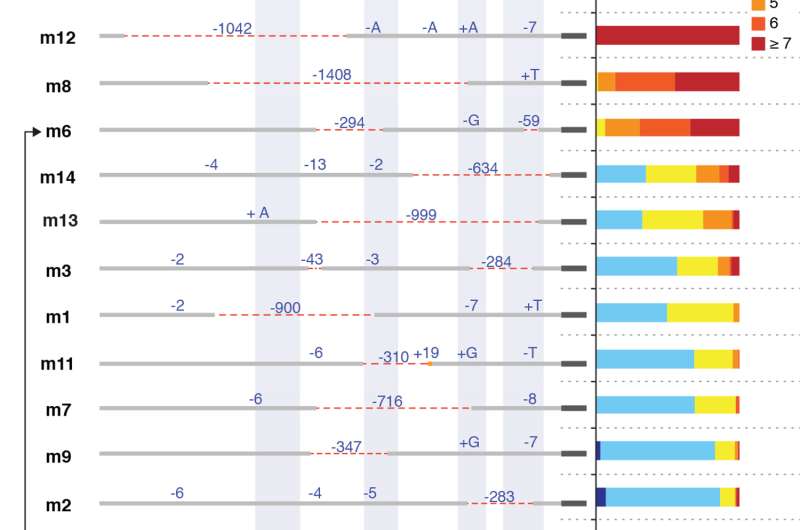Using CRISPR to create different sets of mutations in a gene promoter called SICLV3 (and in several other promoters) enabled researchers to vary the number of floral organs and locules (gelatinous seed compartments) in tomato, over a wide range. The effect is analogous to turning a dimmer switch to vary light levels over a continuous range. The result is the ability to adjust key traits to affect yield. Credit: Lippman lab, CSHL
Scientists at Cold Spring Harbor Laboratory (CSHL) have harnessed the still untapped power of genome editing to improve agricultural crops. Using tomato as an example, they have mobilized CRISPR/Cas9 technology to rapidly generate variants of the plant that display a broad continuum of three separate, agriculturally important traits: fruit size, branching architecture and overall plant shape. All are major components in determining how much a plant will yield. The method is designed to work in all food, feed, and fuel crops, including the staples rice, maize, sorghum and wheat.
"Current rates of crop yield increases won't meet the planet's future agricultural demands as the human population grows," says CSHL Professor Zachary Lippman, who led the research. "One of the most severe limitations is that nature hasn't provided enough genetic variation for breeders to work with, especially for the major yield traits that can involve dozens of genes. Our lab has now used CRISPR technology to generate novel genetic variation that can accelerate crop improvement while making its outcomes more predictable."
The team's experiments, published today in Cell, involve using CRISPR "scissors" to make multiple cuts within three tomato genome sequences known as a promoters—areas of DNA near associated genes which help regulate when, where, and at what level these "yield" genes are active during growth. In this way generating multiple sets of mutations within each of these regulatory regions, the scientists were able to induce a wide range of changes in each of the three targeted traits.
"What we demonstrated with each of the traits," explains Lippman, "was the ability to use CRISPR to generate new genetic and trait variation that breeders can use to tailor a plant to suit conditions. Each trait can now be controlled in the way a dimmer switch controls a light bulb."
This graphic plots changes in gene promoter SlCLV3 induced by making cuts in its DNA sequence with CRISPR gene editing technology. The relative location of 8 guide RNAs used to target cuts in the wild-type (unmutated) sequence of the promoter are represented in the top line by blue arrowheads. After the cuts are made, cellular DNA repair machinery addresses the damage, a process that results in different "repaired" variations of the sequence. Here, 14 different variants, or alleles are listed on the Y axis; moving across each variant sequence from left to right, we see positions where additions and/or deletions of DNA resulted from the CRISPR cuts following repair. The impact of each of these 14 variants of the promoter's sequence upon the number of seed compartments, or locules, in the plant is indicated by the color-coded readout at the far right. They range from 2-3 locules in the wild-type tomato to 7 or more in the m4 and s6 variant alleles. Credit: Lippman lab, CSHL
By using CRISPR to mutate regulatory sequences—the promoters of relevant "yield" genes rather than the genes themselves - the CSHL team finds that they can achieve a much subtler impact on quantitative traits. Fine-tuning gene expression rather than deleting or inactivating the proteins they encode is most likely to benefit commercial agriculture because of the flexibility such genetic variation provides for improving yield traits.
"Traditional breeding involves great time and effort to adapt beneficial variants of relevant genes to the best varieties, which must continuously be improved every year," says Lippman. "Our approach can help bypass this constraint by directly generating and selecting for the most desirable variants controlling gene activity in the context of other natural mutations that benefit breeding. We can now work with the native DNA and enhance what nature has provided, which we believe can help break yield barriers."
Each of the mutated areas creates what are known as quantitative trait loci (QTL). In any given plant, QTL have arisen naturally over thousands of years, the result of spontaneous mutations that caused subtle changes in yield traits. Searching for and exploiting QTL from nature has been an objective of plant breeders for centuries, but the most valuable QTL - those that cause subtle changes in traits - are rare. Lippman and his team have now shown that CRISPR-generated QTL can be combined with existing QTL to create "toolkits" of genetic variation that exceed what is found in nature.
More information: "Engineering quantitative trait variation for crop improvement by genome editing" appears online in Cell September 14, 2017.
Journal information: Cell
Provided by Cold Spring Harbor Laboratory
























